Contents
Poplar rowing is a mushroom that is very helpful for residents of treeless regions. It was brought there along with poplars, which were used to plant windbreaks between fields. The advantage of rowing is that you can get more buckets in one lane.
Description of podtopolnik mushrooms
The rank and file / Tricholomov family is named so not for “love” for geometrically correct constructions, but for crowded growth. In one place, mushroom pickers sometimes pick up 1,5 buckets. Poplar rowing is no exception in this regard.
Its Latin name is Tricholoma populinum from the genus Tricholoma. When determining a poplar row from a photo and description, it is better to focus on Latin. In the regions, the mushroom is called differently:
- subfloor;
- poplar;
- poplar;
- poplar row;
- sandstone;
- sandstone;
- toys;
- frosts
This is the same type of poplar rows, and not different mushrooms. But other representatives of the Tricholomov family can also be called sandpipers and sandstones. Fruiting bodies of tricholoms often “hide” underground. Hence the strange names.
But rows, including poisonous varieties, can be found everywhere in coniferous and deciduous forests. This podtopolnik belongs to the group of conditionally edible.

What mushrooms look like
Often poplar rows look like small hillocks of the earth. Some enthusiasts even look for them with rubber shoes: under the thin sole, a hard lump is well felt. The leg is of medium size: 2-10 cm. Most often, it is about 4 cm high. The diameter (2-4 cm) is almost the same along the entire length. Only at the very mycelium, the leg barely noticeably thickens.
Inside the leg is dense, without cavities, fleshy. Dry consistency. The color is pinkish-brown (in the old) or pinkish-white (in the young). The surface may be smooth or fibrous. Covered with flaky scales. When pressed, brown spots remain on the leg.
In a young podtopolnik, the hat has the shape of a hemisphere. The edges are thin and curved inwards towards the stem. As it grows, the cap straightens, becomes fleshy and slightly curved. The skin is pinkish brown. In rainy weather it becomes slippery. Hat diameter 6-12 cm.
The hymenophore of a young podtopolnik is white, with age the plates become pink-brown. The flesh is white, but under the skin of the cap it has a brownish color. At the break it becomes brown. Opinions about the smell vary. Reference books usually list the pleasant aroma of fresh flour. But some mushroom pickers believe that poplar rowing smells like soap. In fact, there is a high probability that poplar is confused with soap. The latter really smells like fruit soap.
And the reason for the discrepancies, apparently, is again in confusion.
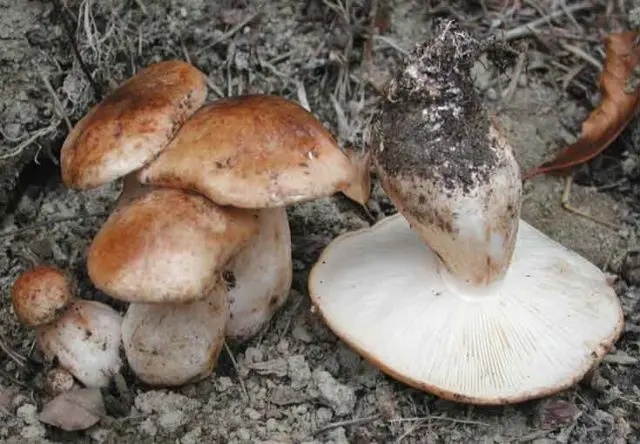
Where do subfloors grow?
Distributed in the south of Our Country and Siberia. They are also found in Europe. They live in symbiosis with poplars, so this species can only be found in natural poplar groves and artificial windbreaks.
The peculiarity of poplar rowing is that it grows in large groups and is not found in ordinary deciduous forests. It forms a symbiosis with poplars and prefers sandy soil. But due to the fact that usually the experience of collecting mushrooms is passed down from generation to generation, confusion often arises with the names. This is how various “false subfloors” appear, but in this case you can usually see a different row in the photo. And it’s good if this species is edible.
It must be remembered that this poplar row is a companion of poplars. Other rows grow in mixed and coniferous forests. Often no less tasty, but not poplar.
When the subfloors grow
The collection time for podtopolniks is mid-August – early October. For harvesting and cooking fresh mushrooms, podtopolniks are harvested young, before the hat has yet opened. Fruiting bodies at this age are solid, there are almost no worms in them.
Variety of subfloors
Strictly speaking, there are no varieties of subfloors. There are more than 2500 species of the family Row. Here are some of them and are considered varieties of the same mushroom. Rows can be taken as a subfloor:
- crowded;
- gray
- earthy;
- green
- brown;
- leopard.
Since these species have a similar growth mechanism (almost underground), they are often mistaken for varieties of podtopolnik. The fact that the places of growth, description and photo of these mushrooms with sandpipers does not match, few people care. At most, they will call it a false sandbox / row.
Most likely for the look. But the valui has nothing to do with ordinary people: this is a family of russula. In the photo, not one of the types of underfloor, but valui. He is a bull. It is enough to cut off the fruiting body to understand the difference: the rowing has a dense leg, while the value is hollow.
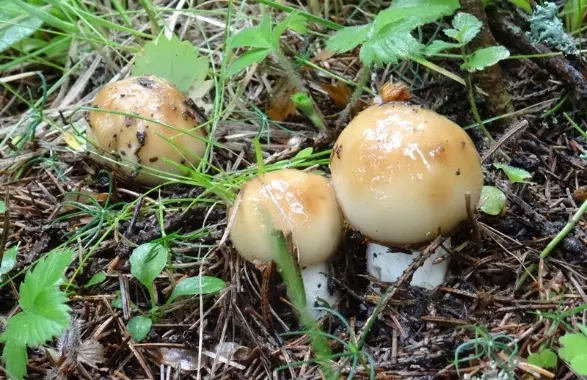
What false subfloors look like
Since in fact they are just representatives of the same Tricholomov family, edible and even more valuable mushrooms are often called false podtopolniks. At the same time, “false sandboxes”, even in the photo, cannot be confused with poplar rows. In nature, this is almost impossible if you know to which type of tree this or that species is “tied” with trichol.
Edible Rows
Quite valuable mushrooms are taken for false podtopolniki, which generally grow either under birch trees or in coniferous forests. The adjective “false” can scare away an inexperienced mushroom picker from several edible and tasty rows:
- sulfur;
- green / greenfinch;
- crowded;
- matsutake.
The latter is considered a delicacy in Japan and has almost all been destroyed.
Gray Row (Tricholoma portentosum)
Other names:
- mouse;
- pine tree;
- serushka;
- dashed line.
It differs from poplar in the gray color of the cap and the species of trees necessary for the mycelium. Mycorrhiza forms with pine. Grows in coniferous and mixed forests. Like poplar, loves sand. Can be found together with greenfinch.
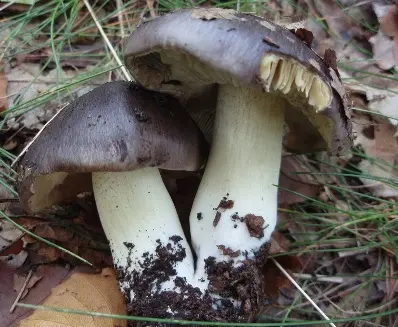
The fruiting seasons of mice and poplar rows coincide in September-October. But serushka in the south of Our Country grows until frost and is never found under poplars.
A good video of the forest, where there are no subfloors, but there are a lot of gray rows.
Green Row (Tricholoma equestre)
She also:
- greenfinch;
- jaundice;
- zelenka;
- golden;
- lemon.
Grows on sandy soils in coniferous forests. Mixed “likes” less, but also found. It comes across one by one or in small groups of 5-8 fruiting bodies. The fruiting season is from September until frost. A common mushroom in the Northern Hemisphere.

Crowded Row (Lyophyllum decastes)
It does not apply to tricholomas. It is a member of the Lillophilum family. But some of the species of this family are also called rows in everyday life. Synonyms for the names of group rowing and crowded lyophyllum.
Young poplar and group rows can be confused. They have similar shape and color. But lyophyllum is smaller in size. There is nothing wrong with confusion, as both species are edible.
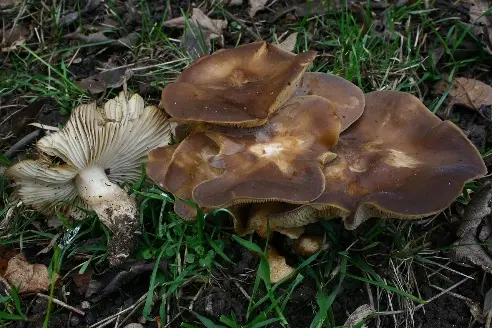
Matsutake (Tricholoma matsutake)
There are no synonyms. In Japanese, the name means “pine mushroom”. It grows in symbiosis with coniferous trees. The main condition for the survival of this species is infertile soil. In the case of improving the quality of the soil, a large amount of decaying organic residues, the fungus dies.
Distributed in the northern regions of Eurasia and America. It is imported to Japan from Scandinavia and Finland.
Externally, matsutake is very similar to poplar row, but differs in smell and taste. Depending on the region, the aroma of the fungus is either pine or reminiscent of cinnamon.
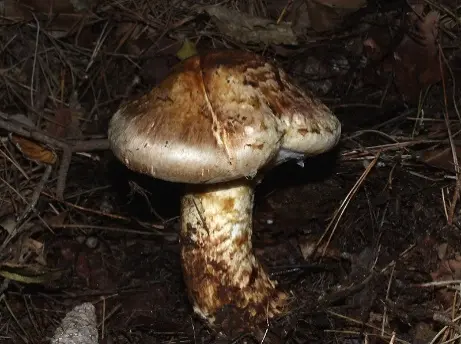
Inedible rows
Among the real rows of the genus Tricholoma, there are relatively few of them. But the genera of talkers and honey agarics also belong to the Tricholomov family.
In the latter, the most famous honey agaric is false. There are many poisonous species among talkers, but they differ from real rows in concave hats. It is difficult to confuse talkers with edible rows.
But among the tricholomas there are poisonous species. Most similar to the poplar row spotted. Leopard still need to try to confuse with other types of mushrooms except fly agaric.
Spotted rowweed (Tricholoma pessundatum)
Second name: lost. Slightly poisonous mushroom. If confused with edible rows, it can cause poisoning. It is dangerous because it is very similar to poplar. The hat is brown, the smell and taste are mealy, like that of a podtopolnik.
It saves from poisoning that this mushroom also grows in forests with coniferous trees. It can only be found near poplars if pines, spruces and other similar trees grow nearby. It grows throughout Eurasia and North America. Fruiting season from September.
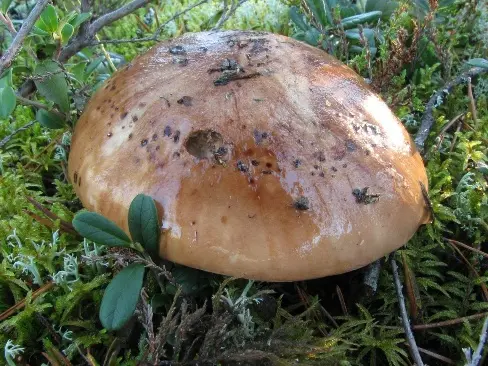
Leopard row (Tricholoma pardinum)
She is brindle and poisonous. It is easy to confuse it with a serushka, but not with a poplar. The hat of the poisonous row of different gray options. The leopard or tiger row is named for the characteristic pattern of the cap, formed by the skin bursting during growth. The grid of cracks resembles leopard spots or tiger stripes.
It grows in coniferous and beech forests, preferring calcareous soil. Occurs rarely. Distributed on the Eurasian and North American continents. It occurs quite rarely. The fruiting season is in August-October.
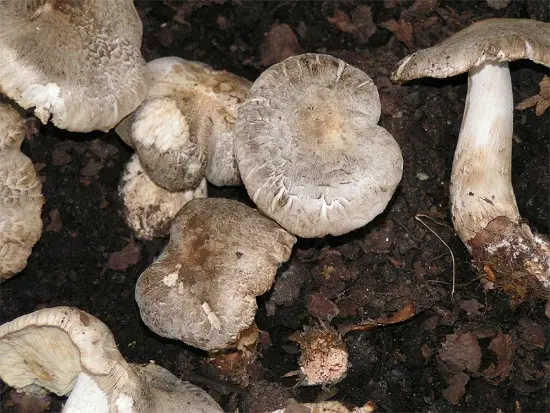
Edible podtopolniki mushrooms or not
Podtopolniki – mushrooms are not poisonous. If they are not confused with a brown row. It is considered poisonous due to its bitter taste. To conduct an experiment and find out whether it is edible or not, while no one dared.
Poplars are edible only after preliminary preparation. And it’s not even about the unpleasant taste, but about the particles of the soil. These mushrooms are called sandpipers for a reason. Most of them grow underground. When harvested, many soil particles remain on the fruiting bodies.
The benefits and harms of podtopolnik mushrooms
The pharmaceutical industry receives the main benefit from poplar tricholomas. They make antibiotics that can fight Koch’s wand. Poplars are rich in vitamins A, C, B. But it is not known how much a person is able to absorb these vitamins. There is an opinion that mushroom pulp is poorly absorbed by the human gastrointestinal tract and comes out practically unchanged. But even in this case, the benefits are undeniable: mushrooms stimulate the intestines.
There is also another belief: poplar rows can be replaced with meat. But this opinion applies to the whole division of Basidiomycetes. And the obstacle is the same as for vitamins: the human gastrointestinal tract is not able to break down and absorb fungal cells. But if this somehow succeeds, then yes, meat can be replaced.
The harm from poplar rows is no more than from other edible mushrooms: they are able to absorb harmful substances from the environment. Podtopolniks collected along the road can be seriously poisoned. Any higher mushrooms are considered heavy food. In case of overeating, it is possible:
- flatulence;
- pain and heaviness in the stomach.
Poplar rows are no exception, so they should not be abused either.
Ruled the collection of poplar rows
When collecting sandboxes in an artificial poplar strip, you need to pay attention to the remoteness of busy roads. You need to go deep into the forest at a distance of at least half a kilometer. If the collection takes place in windbreaks, then you will have to leave 1-1,5 km from the highway, since harmful substances spread further over the fields.
It is better to collect a poplar variety of rows on a non-hot day after the past rains. Then you can reap a really big harvest. You need to take only young fruiting bodies. They have a pink hymenophore and caps that have not yet opened.
When an old specimen is found, it makes sense to carefully examine the area around. Most likely, whole groups of young poplars are hiding under the soil nearby.

The use of poplar mushrooms
Conditionally edible poplar rows cannot be used for cooking immediately after harvest. They are pre-soaked for at least a day in cold water. This helps to clean the young mushrooms of soil particles and remove bitterness.
Water should be no higher than 16 ° C so that the harvested crop does not ferment. For better removal of bitterness and good washing, poplar rows are periodically mixed and the water is often changed. Another way to reduce the bitter taste is to remove the skin from the caps.
After soaking for 1-3 days, the poplar rows are boiled and the water is drained. After all the excess water has drained from the boiled mushrooms, the semi-finished product is ready for use.
Poplar rowing is universal. It can be:
- fry;
- cook;
- marinate;
- salt.
Pickled and salted are used for salads and as a snack. Can be used in any mushroom recipe.
Conclusion
Poplar row is a valuable mushroom that should not be looked for in pine forests. Its “attachment” to poplar trees saves mushroom pickers from being poisoned by poisonous species of rows that can grow along with edible ones in a pine forest or mixed forest.
Reviews about rowing poplar
We have a poplar row almost the only mushroom that can be collected in large quantities. There are no forests, there are only fields around with the same windbreaks. Poplars were planted then because they grow quickly. In season, podtopolniks go to all dishes. But it is better to process immediately after returning home. And you need large containers for soaking.
In our village they are dried, marinated, and salted. It is undesirable to freeze because of the earth. Then you can’t remove it from the frozen row. After defrosting, mushroom tissues are damaged and spread.
We were tempted to go for poplar rows. All the same, you need to eat something, but they were told about them that they were very good. And you can type quickly and a lot. I don’t know, maybe we did something wrong?
We got a lot and quickly. But when they cooked … these mushrooms had some very strange taste. Not bitterness, which could be understood, but as if the soaps were full. Fragrant toilet. Well, maybe they really didn’t get poplar, but some others. Then it’s good that they didn’t get poisoned.









